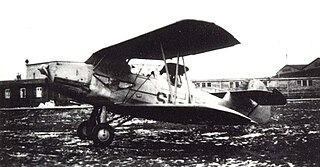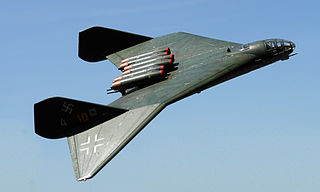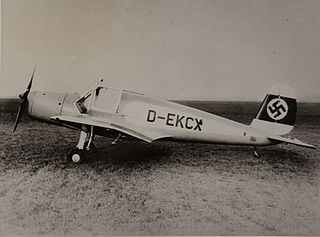Related Research Articles

The Arado Ar 234 Blitz is a jet-powered bomber designed and produced by the German aircraft manufacturer Arado. It was the world's first operational turbojet-powered bomber, seeing service during the final years of the Second World War.

The Arado Ar 196 was a shipboard reconnaissance low-wing monoplane aircraft designed and produced by the German aircraft manufacturer Arado. It was the standard observation floatplane of the Kriegsmarine throughout the Second World War, and was the only German seaplane to serve throughout the conflict.

The Arado Ar 68 was a single-seat biplane fighter designed and produced by the German aircraft manufacturer Arado Flugzeugwerke. It was among the first fighters produced when Germany abandoned the restrictions of the Treaty of Versailles and began rearming.

The Arado Ar 240 was a German twin-engine, multi-role heavy fighter aircraft, developed for the Luftwaffe during World War II by Arado Flugzeugwerke. Its first flight was on 10 May 1940, but problems with the design hampered development, and it remained only marginally stable throughout the prototype phase. The project was eventually cancelled, with the existing airframes used for a variety of test purposes.

The Arado Ar 231 was a lightweight floatplane, developed during World War II in Nazi Germany as a scout plane for submarines by Arado. The need to be stored inside the submarine necessitated compromises in design that made this single-seat seaplane of little practical use.

The Arado Ar 232 Tausendfüßler, sometimes also called Tatzelwurm, was a cargo aircraft that was designed and produced in small numbers by the German aircraft manufacturer Arado Flugzeugwerke. It was designed during the first half of the Second World War in response to a request by the Reichsluftfahrtministerium for a successor or supplemental transport aircraft to the Luftwaffe's obsolescent Junkers Ju 52/3m. The Ar 232 introduced, or brought together, almost all of the features now considered to be standard in modern cargo transport aircraft designs, including a box-like fuselage slung beneath a high wing; a rear loading ramp, a high-mounted twin tail for easy access to the hold and features for operating from rough fields. It was initially requested to be powered by a pair of BMW 801A/B radial engines, however, an alternative arrangement of four BMW Bramo 323 engines was adopted instead due to a lack of capacity.

The Arado Ar 64 was a single-seat biplane fighter designed and produced by the German aircraft manufacturer Arado. It was among the first fighters produced when Germany abandoned the restrictions of the Treaty of Versailles and began rearming.

The Arado Ar 65 was the single-seat biplane fighter successor to the Ar 64. Both looked very similar. The only major difference was the use of a 12-cylinder inline engine versus the Ar 64's radial. The wingspan was also increased.

The Arado Ar 66 was a single-engined twin-seat training biplane designed and produced by the German aircraft manufacturer Arado. It was the last aircraft to be designed by the aeronautical engineer Walter Rethel in collaboration with Arado.

The Arado E.555 was a long range strategic bomber proposed by the German Arado company during World War II in response to the RLM's Amerikabomber project. The E.555 designation was applied to a series of long range jet bomber designs of various sizes, powerplant, crew and weapon load configurations. As design studies only, no aircraft were developed or constructed and the entire E.555 project was cancelled at the end of 1944.

The Arado Ar 197 was a German World War II-era biplane, designed for naval operations for the never-completed German aircraft carrier Graf Zeppelin. Only a few prototypes were built; the project was abandoned in favour of the Messerschmitt Bf 109T and Me 155.

The Arado Ar 96 is a single-engine, low-wing monoplane of all-metal construction, designed and produced by the German aircraft manufacturer Arado Flugzeugwerke. It was the Luftwaffe's standard advanced trainer throughout the Second World War.

The Arado Ar 76 was a German aircraft of the 1930s, designed as a light fighter with a secondary role as an advanced trainer in mind.

The Arado Ar 79 was an aerobatic two-seat trainer and touring aircraft designed and produced by the German aircraft manufacturer Arado. It was the final civilian aircraft developed by the company.

The Arado Ar 199 was a floatplane aircraft, built by Arado Flugzeugwerke. It was a low-wing monoplane, designed in 1938 to be launched from a catapult and operated over water. The enclosed cockpit had two side-by-side seats for instructor and student, and a third, rear seat, for a trainee-navigator or radio operator.

The Arado E.381 was a proposed parasite fighter aircraft. Conceived by Arado Flugzeugwerke in December 1944 for Germany's Luftwaffe during World War II, the E.381 was to have been carried aloft by and launched from an Arado Ar 234 "mother" aircraft. It would then have activated its rocket engine, which would have propelled it to attack Allied bombers. Development was cancelled due to lack of funds and official support.

The Arado Ar E.340 was a twin-engined dive- and tactical-medium bomber, designed by Arado Flugzeugwerke at the request of the Reich Air Ministry in 1939 to compete for a production contract for the Bomber B fast bomber design competition, but the project was cancelled.
The Arado Ar 69 was a two-seat German beginner's school and sport biplane with an open cockpit, developed in 1933 by Arado Flugzeugwerke.

The Arado Ar 77 was a German twin-engined monoplane, designed as an advanced training aircraft from 1934.
The Arado E.583 was a project design from 1945 for a jet-powered night fighter aircraft of the German manufacturer Arado Flugzeugwerke.
References
- ↑ Lednicer, David. "The Incomplete Guide to Airfoil Usage". m-selig.ae.illinois.edu. Retrieved 16 April 2019.